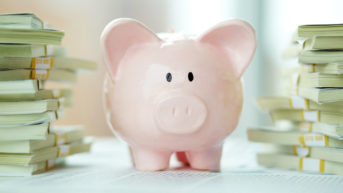Before thinking of getting your first $100,000, review the debt that you owe. It’s pretty common to have credit card debt, lines of credit, a mortgage, or student loans.
Debt can help you build your assets and help you get your first $100,000 when used properly. However, if you find yourself paying more in interest than repaying the principal for debt other than your mortgage, you should talk to a financial advisor and highly consider reducing your debt immediately.
If you have assets of $100,000 but also have $100,000 of debt, your net worth is actually $0. So, when I say, “your first $100,000,” I mean your net worth of $100,000. And that’s just the beginning. We want your net worth to grow to $200,000, $300,000…
Now that we’ve set the goal of getting your first $100,000, let’s go to the first step.
Spend less than you earn
With your eyes set on the $100,000 savings goal, spend less than you earn, so you can save up money. Your savings can then be used to pay off your debt.
Obviously, if you have a mortgage, you must pay it off periodically, most commonly every month. If not, it makes sense to pay off the debt that charges the highest interest rates; typically, it would be your credit cards.

Invest the rest
Once you get some savings, you should look into investing the amount. The U.S. stock market has historically delivered long-term returns of about 10% per year, while the returns from the Canadian market tends to be lower but still much greater than what one would get from fixed-income assets, such as GICs or savings accounts.
By selecting individual stocks, investors can choose the best businesses to invest in. Right now, you can consider Restaurant Brands International (TSX:QSR)(NYSE:QSR). Across +24,000 restaurants around the world, Restaurant Brands generates +US$30 billion of system-wide sales.
Last month, the parent of Burger King and Tim Hortons began the expansion of its newest brand, Popeyes Louisiana Chicken, in Asia, with the Philippines as the first stop, by partnering with local expertise Kuya J Holdings Group via an exclusive master franchise agreement.
Restaurant Brands trades at US$58.78 per share as of writing — that is, a blended P/E of about 23.5, while analysts call for earnings-per-share growth of 13-15% per year for the next three to five years.
While having the potential for double-digit growth, Restaurant Brands also offers a decent dividend yield of about 3% that will pay you a nice income.
Don’t stop at one stock, though. Invest your savings in other great businesses to build a solid portfolio. Combining your diligence to save with investing in excellent businesses that will deliver long-term double-digit rates of return, you can get to that $100,000 much faster.







